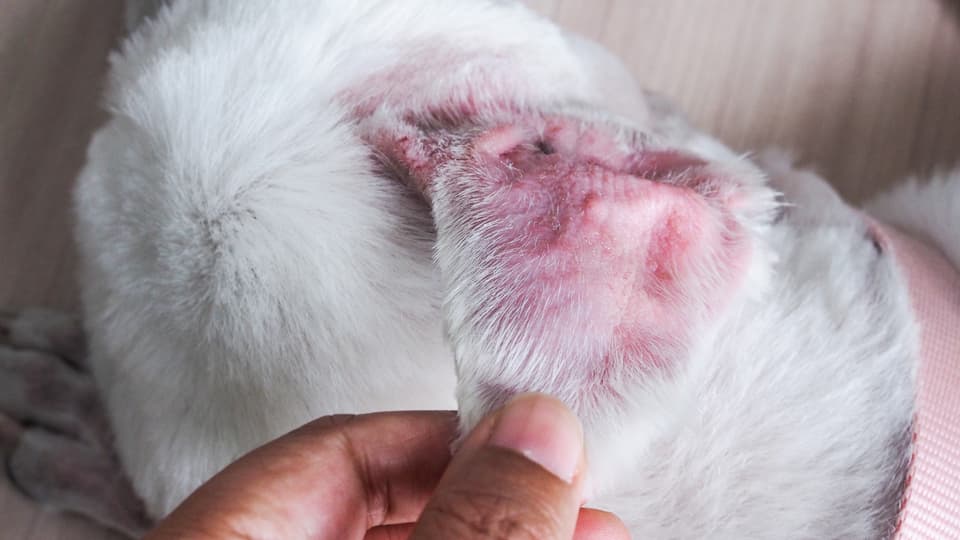If your furry friend seems uncomfortable or spends lots of time itching and scratching at their body, they might have a yeast infection. Dog yeast infections are a common condition that can occur anywhere on the skin and prove stubborn to treat.
In this post, you’ll learn how to recognize the symptoms of yeast infection in dogs, how to treat the condition, and how to distinguish it from bacterial infections and allergic reactions.
Pro Tip: Pet insurance claims for skin conditions tend to cost less than other diseases because the treatments are less invasive. However, your pup may need ongoing medication to control the fungal infection and alleviate itchiness, which can be rather expensive without a pet insurance policy that provides coverage for prescription drugs.
- What causes yeast infection in dogs?
- What are the symptoms of dog yeast infection
- Which dog breeds are most affected by yeast infection?
- How to diagnose yeast infection in dogs?
- How to treat yeast infection in dogs?
- How to prevent yeast infections in dogs?
- Key Takeaways
 (Image source: Paw Culture)
(Image source: Paw Culture)
What causes yeast infection in dogs?
Yeast infection (or yeast dermatitis) is an inflammatory skin condition that commonly occurs in dogs. Yeast organisms are always present on dogs' as part of the body's normal flora, but a fungal infection occurs when there is an excessive amount of yeast in a certain area — usually the ears, skin folds, or between paw pads.
Usually, yeast infections in dogs occur due to a separate, underlying issue. For instance, it's more likely to occur in puppies with compromised immune systems, environmental allergies, or food allergies — especially if they’re taking antibiotics or steroids.
While antibiotics don’t cause yeast, being on them long-term might diminish the presence of healthy flora that helps its levels in control, thereby leading to yeast overgrowth. Steroids can also have a negative effect on your pet’s immune system, which may allow the yeast to overgrow.
Hot or humid weather, a bacterial infection, and underlying skin disease like atopic dermatitis, are also risk factors that can lead to yeast infection in dogs.
Other causes of itchy skin in dogs
A yeast infection is not the only thing that can cause your furry friend to scratch more than usual. Itchy symptoms might signal something entirely different, such as:
Bacterial skin infection
Bacterial skin infections trigger inflammation that can cause your dog to develop redness, rashes, crusts, and pustules on their skin due to toxins produced by bacteria. This might occur if:
- The surface of the skin has been broken
- The immune system has been compromised
- The normal skin bacteria have been changed or altered
- The blood flow to the skin has become impaired
- The skin has become damaged due to chronic exposure to moisture
Ticks, fleas, hormonal imbalances, heredity, as well certain medications can also increase the risk of your pet developing a bacterial skin infection such as pyoderma.
Allergic reactions
Another common cause of itchy skin in dogs is allergies. Whereas humans might sneeze during a mild allergic reaction, dogs tend to experience itchy skin. Food allergies can develop at any time in life, meaning your pup could become allergic to food he or she regularly ate and enjoyed.
Environmental triggers such as mold, dust mites, and pollen could also be responsible for your dog's persistent itching, often with intensified scratching at certain times of the year.
Pet owners will not be able to tell the difference between a yeast infection, bacterial infection, and allergic reaction at home, so the best course of action is to take your pup to the vet.
What are symptoms of yeast infection in dogs?
Only a vet can truly determine the cause behind the constant scratching, but there are a few symptoms that may provide an indication. Unlike allergic reactions and bacterial infections, yeast infection symptoms most commonly affect specific parts of the body.
Ears
Yeast infection in the ear canal is very common in canines. In most cases, there is redness, swelling, and brown discharge, accompanied by a musty or sweet smell. Ear infections are usually very itchy, causing your pooch to rub their head or scratch their ears excessively.
You may also notice other symptoms like crusted skin on the ear flap, loss of hair around the ear, head tilting or shaking, walking in circles, loss of hearing, loss of balance, and unusual eye movement.
Skin
Yeast dermatitis can occur anywhere on a dog’s skin, especially in moist skin folds, around the face and neck, where the legs meet the body, as well as on the anus and vulva.
The infected skin might be itchy, irritated, red, flaky, or greasy, and accompanied by hair loss. If the yeast infection is chronic, the dog’s skin might become thicker and darker. Yeast infections can also affect your pup’s face or mouth, in which case there will be lots of face rubbing and itching.
You might also notice hair loss on the upper back and tail, speckles on the underbelly, rust or grayish color around the genitals, and diarrhea.
Paws
Yeast infections can also affect your pet’s paws making them itchy, red, and irritated. In some cases, this is accompanied by a brown discharge in the nail beds and hair loss. The most affected part of the paws is the underside between the pads. Pups with yeast on their paws tend to lick their paws more than usual.
Which breeds are most affected?
Some dog breeds are more prone to yeast infections than others, based on their body features like many skin folds or genetics. These include:
- American Cocker Spaniels
- Australian Silky Terriers
- Basset Hounds
- Boxers
- Dachshunds
- English Setters
- Poodles
- Shih Tzus
- West Highland White Terriers
- English Bulldogs
- French Bulldogs
Ear yeast infections are more common in dogs with floppy ears, such as poodles, basset hounds, Labrador retrievers, and golden retrievers. Some breeds that have hair growing in the inner ear canal, such as Schnauzers, are also more prone to ear yeast infection.
 (Image source: The Spruce Pets)
(Image source: The Spruce Pets)
How to diagnose yeast infection in dogs
If you notice any of these symptoms, be sure to take your pet to the vet. He or she will perform cytology, i.e. take a sample from the pup’s infected skin or ear and review it under a microscope to confirm if there’s a yeast infection.
Your vet will also analyze the sample for other immune system issues because canines with yeast infections usually also have skin mites or bacterial infections.
How to treat yeast infection in dogs?
The best treatment depends on the location of the infection.
Yeast infection of the outer ear canal is usually treated with antifungal drops or ointment. An infection of the middle ear will be treated with medications (injections and tablets), although additional tests and even surgery might be necessary. Your vet might also recommend a full cleaning of the pup’s ear canal. If the infection is chronic, ask about special ear cleansers you can use at home.
Ear infections can be covered by pet insurance, but it will depend on the type of pet insurance plan you have, as well as other factors like your pup's history. If you are looking for a new insurance policy but your dog has suffered from an ear infection in the past, consider a plan that covers pre-existing conditions.
Treatments for yeast infections on the skin may include medicated shampoo, topical creams, and antifungal sprays or wipes. All these products contain ingredients effective in treating yeast infections such as ketoconazole, miconazole, and chlorhexidine.
In more severe cases, if the problem persists or appears to worsen, oral antifungal medications are also prescribed. These medications should only be used under a vet’s direction.
How to prevent yeast infections in dogs?
Yeast infections can be prevented. Besides making changes and additions to your pup’s diet, you should also consider using an antifungal shampoo. Bear in mind though that for shampoo treatment to be effective, it must sit on your pet’s skin for at least 10 minutes before rinsing.
Dogs with many skin folds might need maintenance treatment to keep these areas from becoming too moist, whereas those allergic to yeast can get an allergy vaccine.
If you suspect your four-legged pal has a yeast infection, talk to your vet for a diagnosis and treatment plan that’s appropriate for your pooch.
Key Takeaways
- Dog yeast infections are very common in skin around the ears and paws, leading to intense itching in the area.
- In most cases, dog yeast infections are easily treatable, but it's best to see your vet as soon as possible.
- Pet insurance can help cover the cost of veterinary care and prescription medication essential to making your pup feel better.
